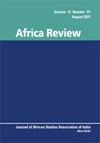IKS和性别生态学
IF 0.5
Q4 AREA STUDIES
引用次数: 0
摘要
两条地质断层线标志着东非大裂谷的最南端。一个古老的构造隆起,或超级井,引起了非洲大陆脊椎的裂谷,形成了奥卡万戈三角洲,这是博茨瓦纳的一个内陆(封闭)湿地。这个巨大的生物多样性水体是一个异常,因为它被贫瘠的喀拉哈里沙漠所包围。这个三角洲的一部分被称为狭长地带。尽管有人类世存在的证据,但这一地区仍大量聚集着野生动物。它也是后殖民时期人类居民集中的地方,其中一些是土著居民。这一人口的每一部分都与环境有着独特的关系,受到土著知识系统(IKS)、地缘政治等级制度和后/殖民民族国家的厌女政治的影响,其中霸权父权制产生了性别化的生态。通过打破等级的方法,本文探讨了后殖民时期潘汉德尔社区的性别生态和IKS。本文章由计算机程序翻译,如有差异,请以英文原文为准。
IKS and Gendered Ecologies
Abstract Two geological fault lines mark the southernmost tip of the Great East African Rift Valley. An ancient tectonic uplift, or superswell, caused rifting down the spine of the African continent, which created the Okavango Delta, an endorheic (enclosed) wetland in Botswana. The huge and biodiverse waterbody is an anomaly, as it is surrounded by the otherwise arid Kalahari Desert. Part of this delta is known as the Panhandle. Despite evidence of the Anthropocene, the area teems with massive concentrations of wildlife. It is also home to a diverse post/colonial concentration of human inhabitants, some Indigenous. Each segment of this population has a unique relationship with the environment, informed by Indigenous knowledge systems ( IKS ), geopolitical hierarchies and the misogynistic politics of the post/colonial nation-state in which hegemonic patriarchies produce gendered ecologies. Through a breaking rank methodology, this paper explores the gendered ecologies and IKS of the post/colonial Panhandle community.
求助全文
通过发布文献求助,成功后即可免费获取论文全文。
去求助
来源期刊

Africa Review
AREA STUDIES-
CiteScore
1.80
自引率
12.50%
发文量
22
期刊介绍:
Africa Review is an interdisciplinary academic journal of the African Studies Association of India (ASA India) and focuses on theoretical, historical, literary and developmental enquiries related to African affairs. The central aim of the journal is to promote a scholarly understanding of developments and change in Africa, publishing both original scholarship on developments in individual countries as well as comparative analyses examining the wider region. The journal serves the full spectrum of social science disciplinary communities, including anthropology, archaeology, history, law, sociology, demography, development studies, economics, education, gender studies, industrial relations, literature, politics and urban studies.
 求助内容:
求助内容: 应助结果提醒方式:
应助结果提醒方式:


